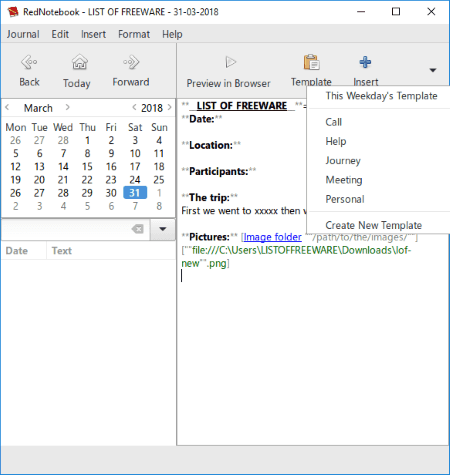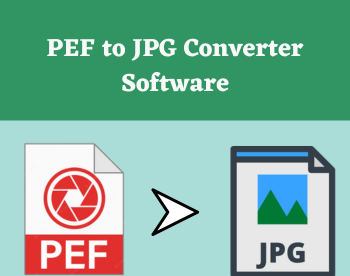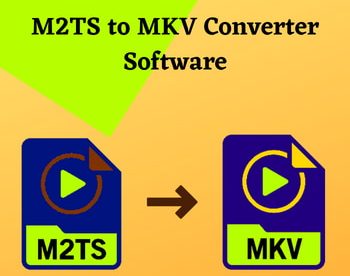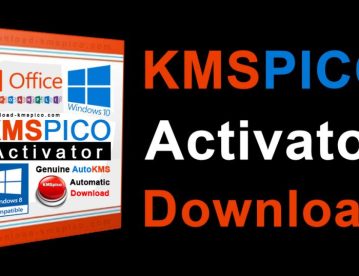9 Best Free Open Source Journal Software For Windows
Here is a list of Best Free Open Source Journal Software For Windows. These are basically journal software whose source code you can easily find from their official websites. The provided source code can be studied, modified, and distributed by any user or anyone for that matter.
Coming to features of these open source journaling software, you can create and store your journals for specific dates using given Calendar. A journal can be of different types such as diary, general ideas, thoughts, todo, Wiki, reviews, blogs, etc. Apart from adding text content, you can insert hashtags, pictures, audio, file links, icons, URLs, date & time, etc. in most of these. Several text formatting options including font size, type, color, text alignment, highlighter, typographical emphasis, bullet list, etc. are also provided. To create secure journals, many of these also offer encryption tool. Some other handy features like word count, character count, journal statistics, backup, etc. are available in few of these.
In most of these, you can export your journals in simple text format, HTML format, or directly print them.
My favorite Open Source Journal Software For Windows:
RedNotebook is one of my favorite free open source journal software as it comes with all required features to create journals. NixNote is also good at it provides several text formatting options.
You may also like some best free Word Processors, Writing Software, and Reference Management Software for Windows.
RedNotebook
RedNotebook is a popular software to create and store journals offline. It is a free and open source journal software for Windows, Mac, Linux, etc. platforms.
It has a pretty simple user interface. From the left side, using Calendar, you can write a journal for a specific date. It provides few templates such as Call, Meeting, Personal, Journey, etc. to start with. Or, you can create a new customized template as well. You can then insert titles, date/time, bullet lists, pictures, file, link, etc. to your journals. You can use hashtags in your journals. Text formatting options like Bold, Italic, Monospace, Strikethrough, etc. can also be used.
You can see formatted preview of your journal in a browser using the dedicated button from the interface. It lets you export your journals in Plain Text, HTML, and Latex formats. While exporting journals, you can select a date range and content (text or tags).
RedNotebook is a very nice and easy to use open source journaling software. It provides few handy features including Statistics (number of words, sentences, distinct words, letters, edited days, etc.), Backup, Spellcheck, Preferences (font, date format, etc.), and Search Bar (to find a journal with a particular text). It comes in a portable version too.
NixNote
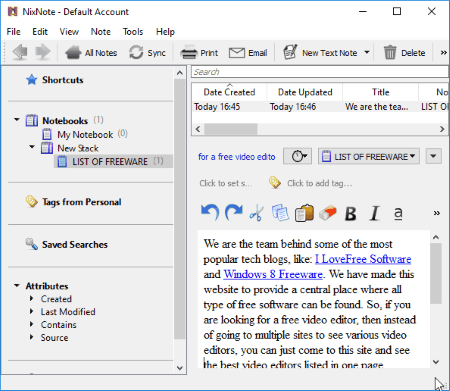
NixNote is another free journal software which is open source. You can add different notebooks and notes for particular dates to create your journals. While writing journals, you can use various text formatting options such as font type, font size, font color, typographical emphasis, superscript, subscript, text alignment, text highlighter, etc. It lets you insert date and time, table, HTML entries, tags, files (images, audio, PDF, etc.), etc. to a journal. It lets you set a source URL and location for your journals too. Additionally, you can add author’s name, reminder due, reminder complete, has to-do, etc. information about your journals.
It provides an encryption feature too so that you are able to create secure journals. You can encrypt selected text within a journal and password protect it. You can view all your journals within a notebook with information like created date, tags, author, size, reminder due, etc. This makes it easier to toggle between several journals without much hassle. Also, you can search for journals with attributes like created date, last modified, sources, content like image, audio, etc., and more.
You can directly print your journals or export them as PDF documents. It also provides features like backup database, pin note, user preferences (appearance, sync settings, etc.), etc.
NixNote is a portable open source journaling software. It is available for Windows and Linux platforms.
KeepNote
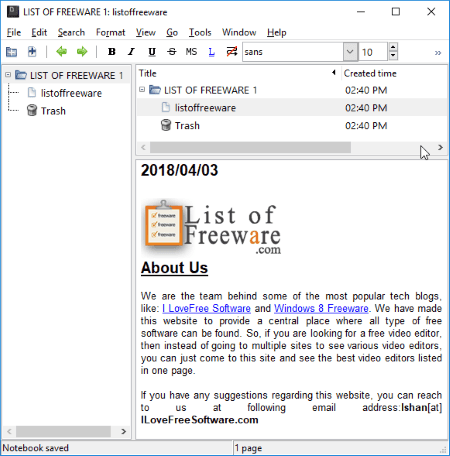
KeepNote is the next open source journal software for Windows. It lets you create journals by creating notebooks and adding pages and child pages to them. In that way, you can simply create private journals, reviews, blogs, articles, etc. types of journals. It lets you insert simple text, horizontal rules, images, screenshots, file attachments, and date. You can format the content using typographical emphasis, font, alignment, etc.
A tree-like view at left panel lets you explore your notebook. You can view a created journal in File Explorer, Text Editor, or Web Browser. You can attach the desired text editor, web browser, etc. to this software using Edit > Preferences > Helper Applications. Additionally, you can customize preferences like Language, File Types, Date Format, Look & Feel, etc. You can easily search for a particular note or journal.
It lets you publish your journals as HTML pages.
KeepNote is a very nice open source software to create journals. It also provides few handy tools like Make Link, Backup Notebook, etc.
Journaley

Journaley is another nice free journal software for Windows. It is an open source journal software as well. You can easily find its source code from its official homepage and study and modify it. It basically lets you create and keep your journals in one place. From its Calendar, you can choose a particular date to write a journal for. Apart from plain text, you can add images (BMP, GIF, PNG, JPEG, etc.) and tags to the journals.
Some other features of this open source journal software:
- You can create secure journals by password protecting the software.
- By right-clicking a journal, you can directly print it or save it as a PDF.
- It provides real-time count of words and characters in your journals.
- Other statistics like total number of journals, number journals this week, etc. are also displayed.
- You can add a journal to your favorites list.
- It lets you view all journals created on a particular day.
- Using its Settings option, you can customize font, enable Spell Checker, choose a language (English, German, French, Spanish), specify a folder to save journals, etc.
All in all, this one can be another option an open source journaling software.
Lifeograph
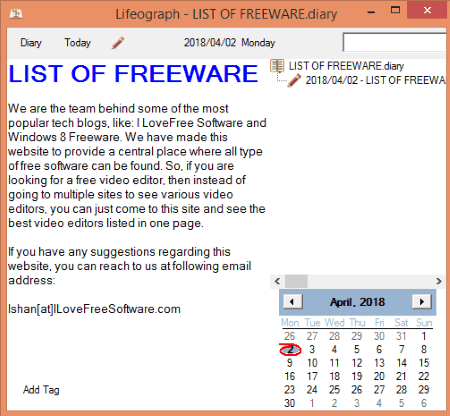
Lifeograph is a free, portable, and open source journal software for Windows. You can create diaries for the current day or a particular date using the Calendar. It lets you make journals with tags and bullet lists. Also, it lets you add a journal to favorite list or add it to Not To Do, In Progress, Done, Canceled, etc. list. You can save diaries in its own format only or export them as TXT files.
It is another decent open source diary software. You can encrypt your diaries with a password to secure them.
Elephant
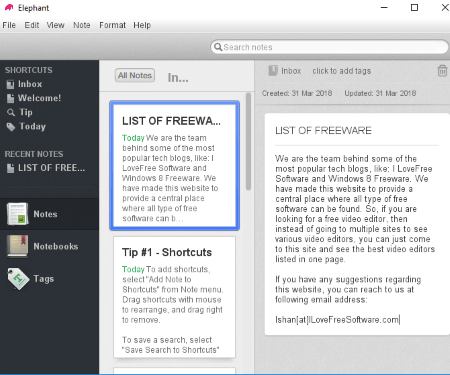
Elephant is one more free and open source journal software for Windows. In this software, you can create notebooks and save notes to them with tags. You can add journals by adding titles and text content to them. It provides basic text formatting options like bold, italic, strikethrough, underline, etc. You can also encrypt (or decrypt) selected text to the clipboard. Other than these features, it provides more such as Search Notes, Word Count, Note Count, multi-window support, etc.
The journals are auto-saved as TXT and RTF files in a user-defined folder.
wikidPad
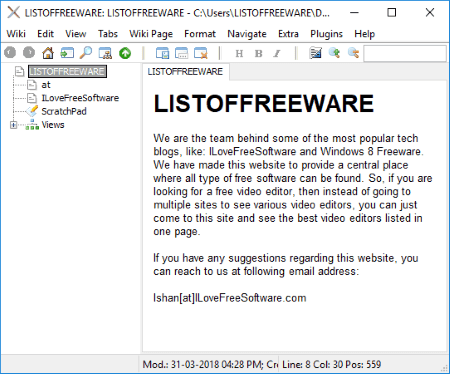
wikidPad is another free and open source software to create and keep your journals. As the name implies, it basically lets you make Wiki-like journals with your thoughts, ideas, todo, etc. While you add a Wiki, it lets you select a database type including Original SQLite, Compact SQLite, and Original Gadfly. You can then start writing your ideas within the created journals. It lets you add contacts, file URLs, icons, etc. You can add links to another page just like any Wikipedia page.
You can save your journal as wiki page in formats like Multipage Text, HTML, .wiki files, etc. formats. You can even include Table of Content in the output.
Hazama
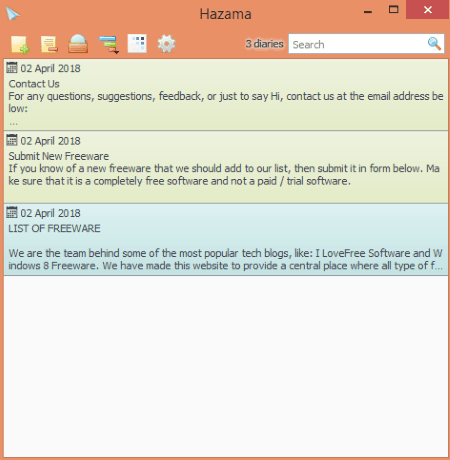
Hazama is another open source journaling software for Windows. It lets you create and save journals for the current day or any other day. The created journals are saved in this software only. From its Settings options, you can set up various configurations. For example, color scheme, fonts (date/time, text, title), language, backup, export (save journals as text files), etc. You can sort your journals by date, length, or title. It provides a Heat Map of Calendar.
It is a simple open source diary software. It comes in a portable package.
Plain Text Journal
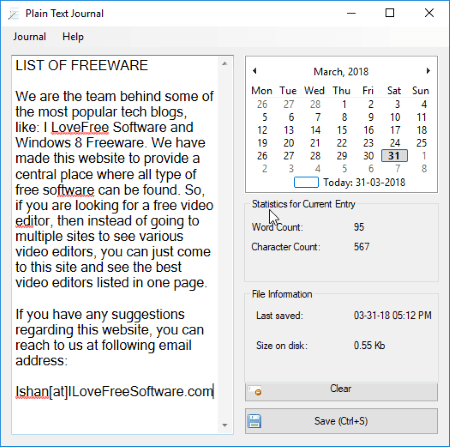
Plain Text Journal, as the name suggests, is a simple open source journal software for Windows. You can choose a date from Calendar provided at right and start adding journals. The number of words and characters are shown in right panel. Your journals are saved as text files in a user-specified folder. That’s it. It doesn’t provide any other features.
It is a portable, open source diary software.
About Us
We are the team behind some of the most popular tech blogs, like: I LoveFree Software and Windows 8 Freeware.
More About UsArchives
- May 2024
- April 2024
- March 2024
- February 2024
- January 2024
- December 2023
- November 2023
- October 2023
- September 2023
- August 2023
- July 2023
- June 2023
- May 2023
- April 2023
- March 2023
- February 2023
- January 2023
- December 2022
- November 2022
- October 2022
- September 2022
- August 2022
- July 2022
- June 2022
- May 2022
- April 2022
- March 2022
- February 2022
- January 2022
- December 2021
- November 2021
- October 2021
- September 2021
- August 2021
- July 2021
- June 2021
- May 2021
- April 2021
- March 2021
- February 2021
- January 2021
- December 2020
- November 2020
- October 2020
- September 2020
- August 2020
- July 2020
- June 2020
- May 2020
- April 2020
- March 2020
- February 2020
- January 2020
- December 2019
- November 2019
- October 2019
- September 2019
- August 2019
- July 2019
- June 2019
- May 2019
- April 2019
- March 2019
- February 2019
- January 2019
- December 2018
- November 2018
- October 2018
- September 2018
- August 2018
- July 2018
- June 2018
- May 2018
- April 2018
- March 2018
- February 2018
- January 2018
- December 2017
- November 2017
- October 2017
- September 2017
- August 2017
- July 2017
- June 2017
- May 2017
- April 2017
- March 2017
- February 2017
- January 2017
- December 2016
- November 2016
- October 2016
- September 2016
- August 2016
- July 2016
- June 2016
- May 2016
- April 2016
- March 2016
- February 2016
- January 2016
- December 2015
- November 2015
- October 2015
- September 2015
- August 2015
- July 2015
- June 2015
- May 2015
- April 2015
- March 2015
- February 2015
- January 2015
- December 2014
- November 2014
- October 2014
- September 2014
- August 2014
- July 2014
- June 2014
- May 2014
- April 2014
- March 2014
